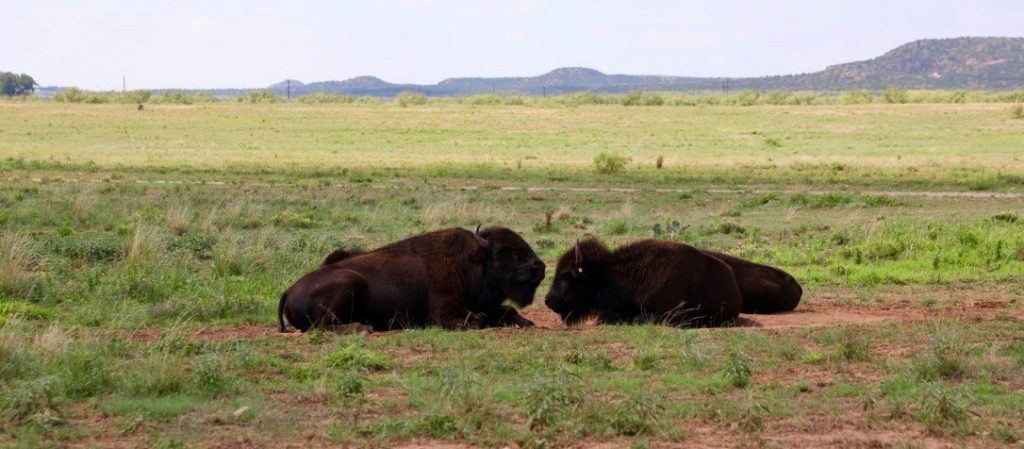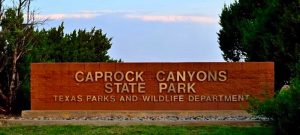
Bison on the plains in Caprock Canyons State Park
Normally, we escape the hot and often humid summers of Texas by heading to the mountainous region of Taos, New Mexico. There, the mornings are much cooler, even in the dead of August, and the high afternoon temperatures are cooled by the gathering clouds and soft breezes of the monsoon rains that squelch the warmth By sunset, the mercury has dropped considerably with the sinking sun, and it’s time to grab a sweater.
Unfortunately, this year, Mother Nature delayed our departure by well over a month. First, we watched with trepidation as the historic Calf Canyon–Hermit Peak Fire burned over 341,000 acres across Northern New Mexico. Such devastating losses for so many! In late August, thanks to an early monsoon season, fire officials announced that the wildfire had been 100% contained.
But with Texas in a drought (in fact 2022 was the driest year on record in the past 128 years) and with no rain for well over 67 days, we decided to delay our departure once again. The 100-degree temperatures continued and started to nudge forty-seven consecutive days of triple-digit heat. Lawns turned a crispy brown and the trees began to drop their leaves – a sign of stress.
During August, two wildfires broke out within less than a mile of our Texas home and later in the month, a fire broke out in a warehouse at a chemical filling and packaging plant within miles of us. As a precaution, neighboring homes and two schools were evacuated. But thanks to the sixty firefighters who responded to the four-alarm blaze, it was soon contained without threatening any of the surrounding homes.
By mid-September we finally felt comfortable about leaving Texas for New Mexico. To break up the long trip – a twelve-hour drive with an hour gained when crossing the border of the two states – we took a friend’s suggestion to stay overnight at the halfway point and recharge, the halfway point being Amarillo, Texas. Our friend wasn’t suggesting staying in town, but recommended reserving a cabin at Doves Rest, practically a stone’s throw from Palo Duro Canyon State Park. Palo Duro is the second-largest “grand” canyon in the US, and I had always wanted to explore this natural attraction. So after thirty-two years of living in Texas, we decided the time had come to see Palo Duro rather drive past it as we had for years on our way to New Mexico.
As research, I watched a few virtual tours of the area and decided it would be a mistake to bypass Caprock Canyons State Park, especially since it was quite near our destination of Palo Duro. But with only one day to explore Palo Duro, a three-hour roundtrip detour south to Caprock didn’t really fit our plans. It made more sense to leave home early on departure day and see Caprock on the outbound trip before check-in time at our Palo Duro cabin.
Cruising through all the small agricultural towns that dot US-287 slows down the drive, but it’s the most direct route, and you can full-throttle your engine as you leave the outskirts of the rural towns, hitting the open, four-lane, divided highway where the speed limit is 75. Personally, I love winding my way through the ranches and farms of the Texas Panhandle. It plays to my love of the land.
 In Estelline, Texas, we left US-287 and steered onto State Highway 86, a two-lane road in good condition. Although it’s a fairly straight shot, the 75-mph speed limit on the narrower road surprised me. With no vehicles in sight, I puttered along at 60, enjoying the terrain. In the town of Quitaque, “end of the trail,” we turned onto Ranch Road 1065 and headed north. We had some doubts about our directions as we appeared to be in the middle of open rangeland nowhere near a state park. Then we spotted the sign for Caprock Canyons State Park. We pulled into the parking lot at the visitor center and waited until the staff returned from their lunch break.
In Estelline, Texas, we left US-287 and steered onto State Highway 86, a two-lane road in good condition. Although it’s a fairly straight shot, the 75-mph speed limit on the narrower road surprised me. With no vehicles in sight, I puttered along at 60, enjoying the terrain. In the town of Quitaque, “end of the trail,” we turned onto Ranch Road 1065 and headed north. We had some doubts about our directions as we appeared to be in the middle of open rangeland nowhere near a state park. Then we spotted the sign for Caprock Canyons State Park. We pulled into the parking lot at the visitor center and waited until the staff returned from their lunch break.
Minutes later, park maps in hand, we set out to explore. Caprock is located along the eastern edge of the Llano Estacado in Briscoe County, and at 15,314 acres in size, it’s the third-largest state park in Texas. We rumbled over the cattle guard and kept watch for the local bison herd. In 1996, the park started their herd with 32 bison. Today the number has grown to around 150. Photographing them was one of the reasons I had put Caprock on my “must do” list.
We were making our way up the hill toward Lake Theo when a small herd of four bison descended the incline and came toward us. As they drew closer, they left the grassy shoulder of the road to use the pavement as their hoof path. We stopped our SUV to give them the right of way, and I waited, camera in hand, to photograph them. Then the unexpected happened. The four grew to ten, twelve, fourteen, as they crested the ridge and surrounded our vehicle, close enough for us to touch them through the open windows. Not that we would. We held our breaths and hoped Bullet wouldn’t bark at them. They slowed to a crawl and then moseyed on by, a herd of twenty making their way down the road. In retrospect, I’m sorry I didn’t think to video them. In the moment, though, I was more concerned about startling them and risking harm to human, canine, or bison
One of my reasons to visit Caprock Canyons was to photograph the bison herd, which wasn’t as successful as I’d hoped. But the other reason was to film the rugged beauty of the rocky terrain, and I think maybe I was more successful there. In my next blog post I’ll share some shots I captured of the red cliffs and let you be the judge.
For a history of how the Caprock bison herd came to be: https://www.wewillnotbetamed.org/the-bison-of-caprock-canyons-state-park/


0 Comments